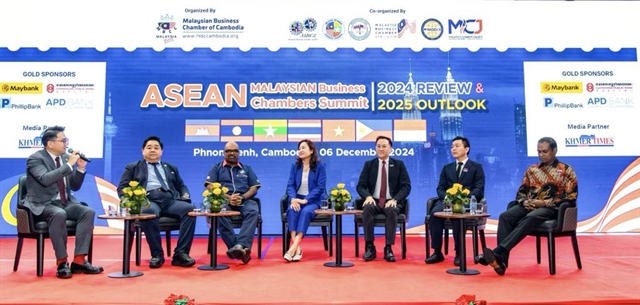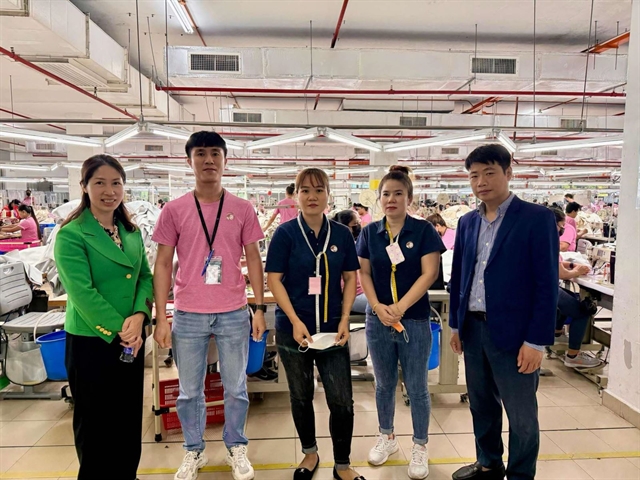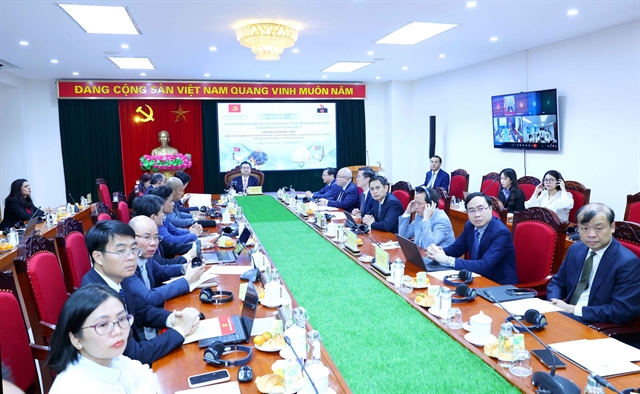 Economy
Economy

 |
| Lê Ngọc Toàn, First Secretary and Head of the Labour Management and Expert Committee in Malaysia (right), and Thái Thị Hương, First Secretary (left), pose for a photo with Vietnamese workers at the Ramatex Textiles factory in Johor, Malaysia. — VNA/VNS Photo |
KUALA LUMPUR — As of November 30, more than 17,000 Việt Namese workers had been working legally in Malaysia, according to the Malaysian Ministry of Human Resources.
Although this figure has decreased by about 50 per cent compared to the peak in 2003, the two countries' authorities still appreciate their practical labour cooperation.
According to the general assessments of employers, Vietnamese workers have good skills, learn very quickly, are diligent, and easily integrate into work and life in Malaysia.
With good experiences, skills and foreign languages, Vietnamese workers are often appointed as team leaders of production lines, guiding and supporting workers in other countries such as Myanmar, Nepal, Sri Lanka and Bangladesh.
Of the Vietnamese workers in Malaysia, more than half of them work in the manufacturing sector, about 10 per cent in the construction sector, more than 10 per cent in the service sector, and 10 per cent in the agricultural sector.
In 2003, the Governments of Việt Nam and Malaysia signed the first cooperation agreement on sending Vietnamese labourers to work in Malaysia. The agreement was re-signed in 2015 and 2022 within the framework of then Prime Minister Ismail Sabri Yaakob's official visit to Việt Nam.
Sending Vietnamese workers to work in Malaysia is one of the effective cooperation contents, especially in the 2002-2012 period.
The year 2003 was considered the peak period as Malaysia recruited 38,000 Vietnamese workers to meet its labour demand.
Roland Hoo Choon Leng, distribution manager of Gimmill Industrial (M) SDN. BHD, a company of Ramatex Textiles Group, said that currently the group is applying automation in the textile and garment process, so it is very necessary to have workers with good skills like Vietnamese workers.
He said besides good skills, Vietnamese workers are very diligent in learning foreign languages, many workers can speak both Chinese and Malaysian, so they start working and integrate with local life very well.
The group has also invested in Việt Nam with three factories operating in Hải Phòng city, and Bắc Ninh and Nam Định provinces. Meanwhile, its factories in Batu Pahat and Kulai, Johor are employing more than 9,000 workers, most of whom are foreign workers, including about 300 Vietnamese workers.
Lê Ngọc Toàn, First Secretary and Head of the Labour Management and Expert Committee in Malaysia, said that although Prime Minister Anwar Ibrahim's government has approved a plan to raise the minimum wage from 1,500 RM to 1,700 RM per month (approximately VNĐ10 million) starting from February 1, 2025, this is not very appealing to Vietnamese workers.
This is because Vietnamese labourers have better options in the markets of Japan, the Republic of Korea, and Taiwan (China), where they can earn higher incomes. However, Malaysia is still considered one of the top markets for Vietnamese manual labourers, as it does not demand high levels of foreign language proficiency and skills.
Regarding the goal of effectively exploiting the potential for cooperation between the two countries in the labour sector, Toàn believed that Việt Nam should focus on tapping into the skilled labour market segment with high professional qualifications. He noted that this is a new aspect of cooperation between the two countries, as Malaysia is attracting significant foreign investment in the service and high-tech sectors. — VNS




